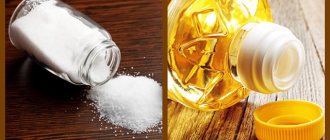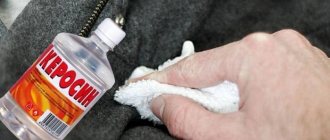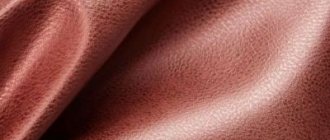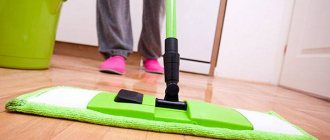After repairs and other work with various materials and substances, it can be very difficult to get your nails and skin in order. Often, traces of stubborn dirt cannot be completely removed with ordinary soap and a brush. Some try to get rid of them using more aggressive methods that can damage the skin. There are also special means for getting rid of various types of dirt . These liquids can be purchased at the store or prepared independently at home.
Cleansing skin and nails from fuel oil
To remove traces of fuel oil from your hands, it is recommended to use the following methods:
- Getting rid of stains using chemicals (washing powder, special store-bought compositions for cleaning stubborn stains from leather, car shampoo or solvents, the safest of which is motor oil).
- Removing dark matter using folk remedies that do not have such an aggressive effect on the skin.
The first method of preparing a composition that can remove traces of fuel oil from clothes : you need to take a container, pour a handful of starch and soda into it, pour in ammonia and turpentine (0.5 tbsp each). Mix the ingredients to a paste , apply to the skin of your hands or clothes and wait until the substance dries. Wash off with warm water and soap. You just have to pay attention that this product can ruin dyed fabrics. Therefore, before using it, it is better to test it on a small piece from the reverse side. The second fairly effective substance for cleansing the skin of fuel oil is coffee grounds. You just need to rub your hands and other dirty areas well with it, and then wash it off along with the dirt.
Elderberries also have cleansing properties., with their help you can easily get rid of fuel oil on the skin. To do this, you need to crush them and rub them thoroughly with your hands - the dirt will come off. Unripe red currants or gooseberries have approximately the same effect. Sorrel can be used for the same purposes.
How to wash fuel oil from clothes at home
It is unsafe to use aggressive chemical compounds at home - harmful fumes can poison a person. Folk remedies effectively fight greasy stains. To remove fuel oil stains, use butter, soda, ammonia, aromatic oils or laundry soap.
Hand wash for oil stains
Pastes for cleaning hands from stubborn stains can be purchased at the hardware department or auto store. They remove even stubborn stains. Apply a small amount of the mixture to the oil stain, rub in gently, and rinse with warm water. This paste can remove stains from leather products. The most popular product is “Auto-Master”, it costs around 50 rubles.
Removing traces of acrylic paint
Acrylic paint is water-soluble with a film-forming agent in its composition, and if you thoroughly wash your hands with soap immediately after finishing the repair work, not a trace will remain of it .
But the situation is different with stains that have dried out and are quite deeply ingrained into the skin and nails. During this time, the film former hardens, and it becomes a little more difficult to wash off the paint .
In order to wipe acrylic paint from the skin after 30-60 minutes and up to a day, you need to use any product that can break down fat. This could be dishwashing liquid, vinegar, or solvent. To soften a hardened stain, you need to rub it more than once. If the traces of acrylic paint are more than a day , then it is more difficult to deal with them; you will need other means, such as white spirit, kerosene or gasoline . Acetone or nail polish remover without acetone can also help. To soften the film, you need to act on the stain for at least half an hour. The downside is that these liquids are quite aggressive on the skin, so after using them you need to use a nourishing hand cream or restorative baths.
Useful tips
In order to reduce the contamination of your hands with fuel oil, before working with automotive and technical components, adhere to the following recommendations:
- Use fabric gloves, which, although partially, will still protect your hands from contamination by technical substances.
Important! The only component when repairing which the use of gloves would be inappropriate is the carburetor. This is due to the fact that there is a danger of fabric fibers getting into the jets and channels of the system.
- You can also apply so-called “dry gloves” to the surface of your hands - compositions that are applied to the skin of your hands even before you start working with technological parts. This covering of hands will significantly simplify further washing of contamination.
- A transparent film of laundry soap will also effectively protect the skin of your hands from contamination; you should use it to lather your hands before starting repair work and wait until the product dries.
Removing oil paint marks
If your hands are slightly dirty, butter or vegetable oil can help solve this problem.
You need to take a small amount onto a cloth and rub the stains with it until they dissolve. This may take some time, but it will not harm the skin. Among chemical products, nail polish remover can help. The same white spirit or acetone. These liquids are usually used if the area of contamination is large. But they can dry out the skin a lot, so after cleansing you need to use a cream.
| If dye gets on your hair, it is better to remove it with oils. |
We use an iron
Fuel oil resins can be broken down not only by chemical means, but also by exposure to high temperature. This method is only suitable for dense fabrics, since thin and delicate ones will not withstand high temperatures.
For the procedure you will need a blotter from a school notebook or a paper towel. A piece of paper is placed on both sides of the stain and ironed with a hot iron. The action must be repeated 2-3 times, changing the paper. Remains of fuel oil are removed additionally with dishwashing detergent.
Means for removing traces of machine oil
Any person, even those who do not deal with car repairs, can encounter a stain from machine oil, because you can get dirty with this liquid even on escalators or in public transport. It is not so easy to wash off these stains, but it is quite possible.
If the stains are fresh and small in size, regular laundry soap with 72% fat content will help. You need to thoroughly wash your hands with it, using a brush if necessary. There is also a rather unusual way to remove machine oil stains from your hands - you just need to buy a carbonated drink like Coca-Cola. You need to wash your hands with it, then with water and then use the cream. You can also get rid of fresh marks using butter or vegetable oil by rubbing your hands with a cotton pad or napkin soaked in it. Baking soda diluted with water to form a thick sour cream can remove strong traces The mixture is applied to contaminated areas and rubbed into the skin, then washed off with warm water. You can also use dishwashing detergent for cleaning. This liquid will get rid of traces of machine oil in 3 minutes , but they may remain under the nail plates and will have to be bleached. If the skin reacts with irritation to the procedures, you need to use a cream with a thick consistency. white spirit will help get rid of it . Apply a small amount of this liquid to a cloth and rub the problem area with it, then wash your hands well with soap and apply a rich cream. There are also pastes specially created for washing motor oil. They do their job well and cleanse not only the skin, but also the nail area from stains, without having a negative effect on them. Moreover, to remove marks you don’t need water at all, just a few napkins.
Preventive measures
There are several “folk” preventive measures that make it easier to wash your hands after repairing a car. The simplest of them is to work with gloves. Especially if the work involves very dirty parts. The main thing is to choose good gloves, in particular, rubberized ones or with rubber notches applied to their inner surface, preventing the tool from turning in the palm.
Also, before work, you can lubricate the surface of your hands with liquid soap (or dissolved solid soap) and let it dry. Thus, a certain protective layer is formed on the skin, on which all the dirt will remain and not penetrate the skin. At the end of the work, hands are washed quite simply, even without the use of special products and pastes.
After washing your hands with any of the above products and regular soap, it makes sense to apply protective creams to the skin for preventive purposes - for example, traditional baby cream or special compositions to protect the skin of the hands (usually always in a woman’s home cosmetics bag, so you can ask your girlfriend/wife ). Such creams will not only help get rid of dry skin, but will also allow it to be less sensitive to pollution in the future.
How to remove traces of cement from hands and nails
Cement is a rather harmful substance for the skin. Those who have ever gotten dirty with it know that it causes dryness, itching and burning.
Sometimes cement masses can even corrode the skin. Therefore, removing this unsafe composition from your hands is a priority task after repair work. Fresh cement marks can be washed off with soap or another detergent. But after a while the mixture dries out and you have to look for another way out. Special store-bought detergents containing an abrasive substance can come to the rescue. After removing the cement, it is very important to take care of the skin, lubricate it with a nourishing cream or even healing ointments, such as “Rescuer” (if there are obvious damage to the skin).
Removing sealant and plaster stains from hands
If you were not wearing gloves during repairs and there are traces of plaster or sealant left, the following methods will help you get rid of them:
- apply medical alcohol to a cloth or cotton pad and wipe problem areas;
- instead of alcohol, you can use gasoline or nail polish remover containing acetone;
- try to clean the skin with a cloth soaked in a 3% vinegar solution .
- Moreover, fresh plaster stains from the skin of your hands can be removed using water and regular soap.
Stain on outerwear
It is most difficult to clean stains from down jackets, jackets, raincoats and coats, since the fabrics from which they are made cannot withstand the effects of aggressive agents. First, it is better to try to deal with the stain using dish soap or tar soap.
If the result is unsatisfactory, a second attempt should be made using car shampoo. A demi-season jacket can be washed completely with shampoo.
For a down jacket, only surface treatment of dirt followed by washing with regular powder or liquid is suitable.
Stains from Bolognese jackets can only be removed with laundry soap. You first need to drop essential oil (fir, eucalyptus) onto the area of contamination. Then rub the dirty area with soap and rinse.
You shouldn’t take risks trying to remove a fuel oil stain from a fur coat, sheepskin coat or leather jacket. In this case, it is better to seek help from professionals - dry cleaning workers.
Cleansing skin from hardened glue and superglue
The biggest problem for people is removing glue like “Moment” or “Second” . These are quick-setting compounds that leave a hard film after drying. How to remove it? This can be done in several ways:
- Purchase a special product at the store to corrode such compounds. They cost around 70 rubles and cope quite effectively even with old stains from superglue ( "Contact", "Strength" and others). If it is necessary to remove marks on any surface, the gel is spread over it and left for about an hour. The product stays on the skin for no less time. As soon as the superglue layer begins to become softer, you need to take soap and a brush and remove it under water.
- Some use abrasive materials to scrape off hardened glue (pumice and others ). But if the layer is very thin and the mechanical forces are intense, then the skin can be injured.
- If it is not possible to get to the store and purchase a special remover, you can use chemical liquids available at home. It can be white spirit, acetone. These products will not remove superglue as effectively, but in a few steps they can do the job. After using them, you need to wash your hands with soap and protect your skin with a rich cream.
- If the skin is very sensitive and reacts strongly to chemical solvents, you can take a small amount of ordinary salt and rub it between your palms for a while. It is better to perform this procedure after first soaking your hands in hot water. After white foam forms, rinse it off and apply nourishing cream to the skin. A body scrub with a large number of large particles can also cope with the function of salt.
- The pharmacy sells Dimexide , which can also soften frozen superglue. To do this, you need to apply it to the fabric and apply it to the stain. After a few minutes, when it softens, remove with warm water and a sponge.
If the glue is not completely wiped off, do not be upset. After a few days, it will detach itself along with the dying pieces of skin.
Graphite Grease Removers
Graphite grease is not easy to remove from skin. dishwashing detergent for this purpose to dissolve the dirt. But you shouldn’t expect clean nails, and the skin will be dry after the procedure, which will require additional moisturizing. Gasoline will help wash off graphite grease almost instantly. Although it is better to save this product for various surfaces or clothing, and not for the skin, since this substance has a very negative effect on human tissues and organs. It is better to always have with you a special remover for complex skin stains, which contains much less substances that destroy the lipid layer of the skin than the same washing powder or dishwashing detergent.
What should be the composition
Before you make a cleansing paste with your own hands, you need to know about the basic requirements that such a product must meet. Among them:
- Contain no solvents. They are harmful to the skin and the human body as a whole.
- Have a neutral pH number. That is, to be neither acidic nor alkaline, but neutral.
- The composition should contain moisturizing (and better yet, antiseptic) agents to protect the skin.
- Be hypoallergenic. This means that if you are allergic to any products or individual elements, you cannot use them in the cleansing composition for obvious reasons.
Following these simple rules will allow you to create not only an effective, but also a safe solution for removing impurities from the skin of your hands.











